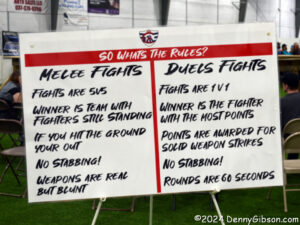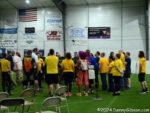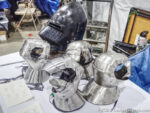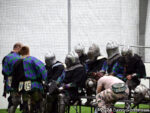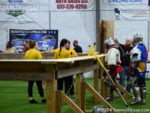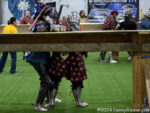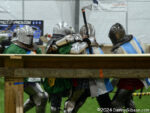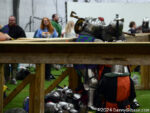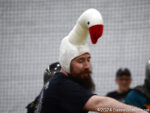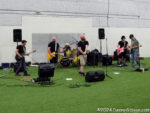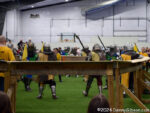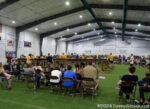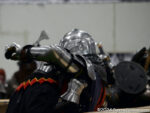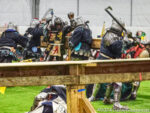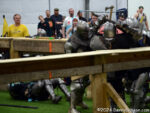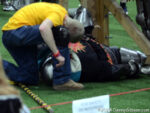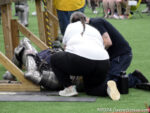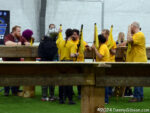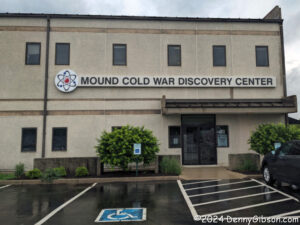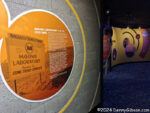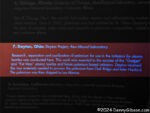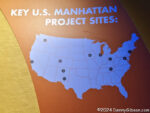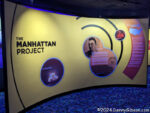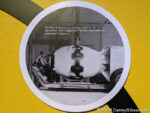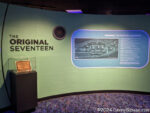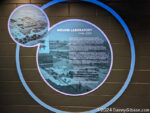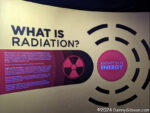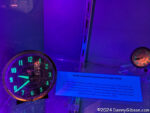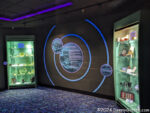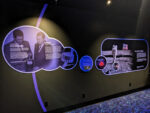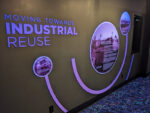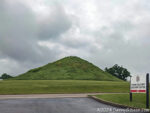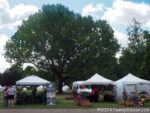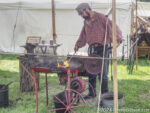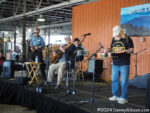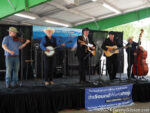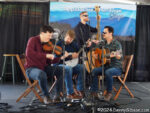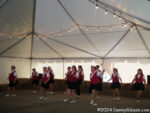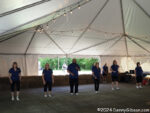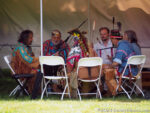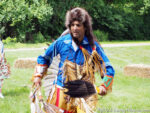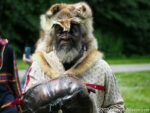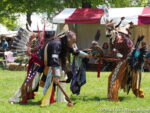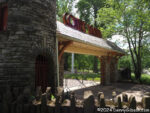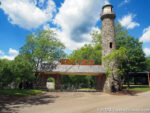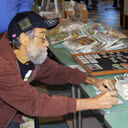I’ve read a fair amount of Sword & Sorcery fiction and played a little Dungeons & Dragons but my medieval role-playing never made it beyond washing down a turkey leg with mead at the local Renaissance Festival. On Saturday I was a slightly out-of-place spectator where some sword-related role-playing was happening with people who take it very seriously and have the bruises to prove it. This weekend Cincinnati Siege 2024, “The biggest armored combat event in Ohio”, is taking place in nearby Mount Orab under the auspices of the Cincinnati Barbarians.
It is a two-day event which means it is half over. 1-on-1 duels are happening today. I attended 5-on-5 melees yesterday. I arrived just a few minutes after the 10:00 AM opening time and found a meeting in process. Most of the participants were wearing yellow shirts which I later learned identified the event marshalls so I imagine they were going over rules and procedures. I can’t say for sure that they put extra emphasis on the “No Stabbing” thing but it seems like a good idea.
The first combat was scheduled for 10:30 and would actually start a few minutes after that. I used some of the time to look over the small merchandise area.
When I returned to the arena, metal-clad fighters were gathering and it wasn’t too long before the first of them began entering the wood-fenced field of combat.
And in short order, contestants were merrily clashing, bashing, and slashing — but not stabbing — each other in groups of ten.
Combatants are not allowed to rise once they have fallen and toppling opponents is the single goal of of every contestant. Sometimes that is accomplished by sheer strength, sometimes by a well-placed blow from a blunt but heavy weapon, and sometimes by simply crashing into them. The run-and-crash technique was often effective if the target was caught off guard but, if not, a runner’s momentum could easily be used against them.
Teams included unarmored members who carried extra weapons, supplied water, attached and adjusted armor, and just generally handled all the tasks that people encased in steel plates and chain mail can not do.
There was a cease-fire for lunch with music provided by Toxic Nobility from Dayton, Ohio. I had been looking forward to some relaxing and period-appropriate Gregorian chants but that was not to be. I have a hunch you can guess what style of music these guys performed. They were pretty good at it as far as I could tell.
The smashing and bashing, of course, resumed in the afternoon. Event advertising said that there were eighteen teams competing and I read somewhere that the teams fighting their initial bouts in the afternoon were not the same as those appearing in the morning. I believe that but can not verify it as I could understand very few of the PA announcements and could identify very few of the teams.
Eventually, the top teams from the morning session reappeared to compete with the top afternoon teams. I did not understand the overall tournament structure and standings but I didn’t know anyone so just rooted for everyone. One of the few things I did know was that each contest was “best of three” and in the afternoon I verified my guess that a round was ruled a draw if the last members of both teams fell over at the same time. This was not uncommon since falling warriors frequently took an enemy or two down with them. I also learned that a battle ended when a single member of one team remained against three or more of the opposing team.
There were no real injuries as far as I know but there were a few times when a fallen fighter was slow to get up. Medics were called in a couple of times but in all the cases I was aware of the player eventually stood up and walked away.
Things got even more serious in the final rounds and there were a couple of protested calls. Of course, I have no idea what they involved since I didn’t understand the rule, the violation, or the call or the lack thereof. In at least one instance, the protest was resolved by viewing a smartphone video taken by an unarmored member or friend of one of the teams.
In the end, all protests were resolved and champions were determined. For women they were: 1st Rust in Peace, 2nd Ordo Obelios “Waffles”, and 3rd Order of the Pegasus. For men they were: 1st Warlord Combat Academy, 2nd Knyaz USA – Medieval Fighting Club, and 3rd Company of the Pale Horse. I don’t believe the fellow at right was on any of those teams but I really liked him and wanted to post a picture. I think that’s because he somehow reminds me of Monty Python’s Black Knight. I’m sure there are many excellent videos of the day out there but my own smartphone recording of a rather mild random battle of the day is here.

